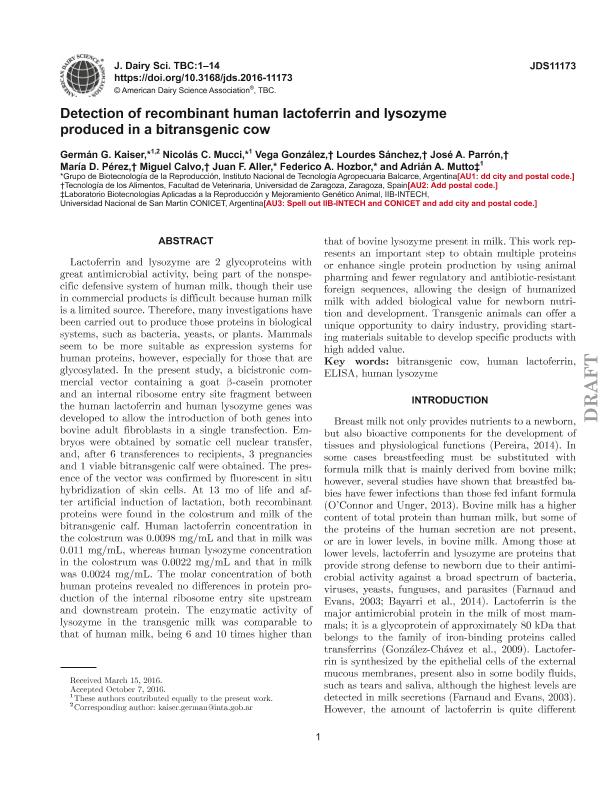Artículo
Detection of recombinant human lactoferrin and lysozyme produced in a bitransgenic cow
Kaiser, Germán Gustavo; Mucci, Nicolás Crescencio; González, Vega; Sánchez, Lourdes; Parrón, José A.; Pérez, María D.; Calvo, Miguel; Aller Atucha, Juan Florencio; Hozbor, Federico Andrés; Mutto, Adrián Angel

Fecha de publicación:
03/2017
Editorial:
American Dairy Science Association
Revista:
Journal of Dairy Science
ISSN:
0022-0302
Idioma:
Inglés
Tipo de recurso:
Artículo publicado
Clasificación temática:
Resumen
Lactoferrin and lysozyme are 2 glycoproteins with great antimicrobial activity, being part of the nonspecific defensive system of human milk, though their use in commercial products is difficult because human milk is a limited source. Therefore, many investigations have been carried out to produce those proteins in biological systems, such as bacteria, yeasts, or plants. Mammals seem to be more suitable as expression systems for human proteins, however, especially for those that are glycosylated. In the present study, a bicistronic commercial vector containing a goat β-casein promoter and an internal ribosome entry site fragment between the human lactoferrin and human lysozyme genes was developed to allow the introduction of both genes into bovine adult fibroblasts in a single transfection. Embryos were obtained by somatic cell nuclear transfer, and, after 6 transferences to recipients, 3 pregnancies and 1 viable bitransgenic calf were obtained. The presence of the vector was confirmed by fluorescent in situ hybridization of skin cells. At 13 mo of life and after artificial induction of lactation, both recombinant proteins were found in the colostrum and milk of the bitransgenic calf. Human lactoferrin concentration in the colostrum was 0.0098 mg/mL and that in milk was 0.011 mg/mL, whereas human lysozyme concentration in the colostrum was 0.0022 mg/mL and that in milk was 0.0024 mg/mL. The molar concentration of both human proteins revealed no differences in protein production of the internal ribosome entry site upstream and downstream protein. The enzymatic activity of lysozyme in the transgenic milk was comparable to that of human milk, being 6 and 10 times higher than that of bovine lysozyme present in milk. This work represents an important step to obtain multiple proteins or enhance single protein production by using animal pharming and fewer regulatory and antibiotic-resistant foreign sequences, allowing the design of humanized milk with added biological value for newborn nutrition and development. Transgenic animals can offer a unique opportunity to dairy industry, providing starting materials suitable to develop specific products with high added value.
Palabras clave:
HUMAN LACTOFERRIN
,
RECOMBINANT
,
BI TRANSGENIC COW
,
ELISA
Archivos asociados
Licencia
Identificadores
Colecciones
Articulos(IIB-INTECH)
Articulos de INST.DE INVEST.BIOTECNOLOGICAS - INSTITUTO TECNOLOGICO CHASCOMUS
Articulos de INST.DE INVEST.BIOTECNOLOGICAS - INSTITUTO TECNOLOGICO CHASCOMUS
Citación
Kaiser, Germán Gustavo; Mucci, Nicolás Crescencio; González, Vega; Sánchez, Lourdes; Parrón, José A.; et al.; Detection of recombinant human lactoferrin and lysozyme produced in a bitransgenic cow; American Dairy Science Association; Journal of Dairy Science; 100; 3; 3-2017; 1605-1617
Compartir
Altmétricas



